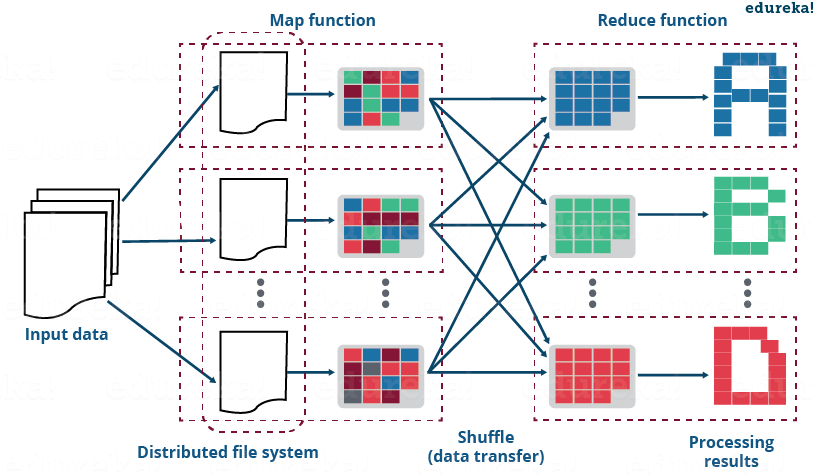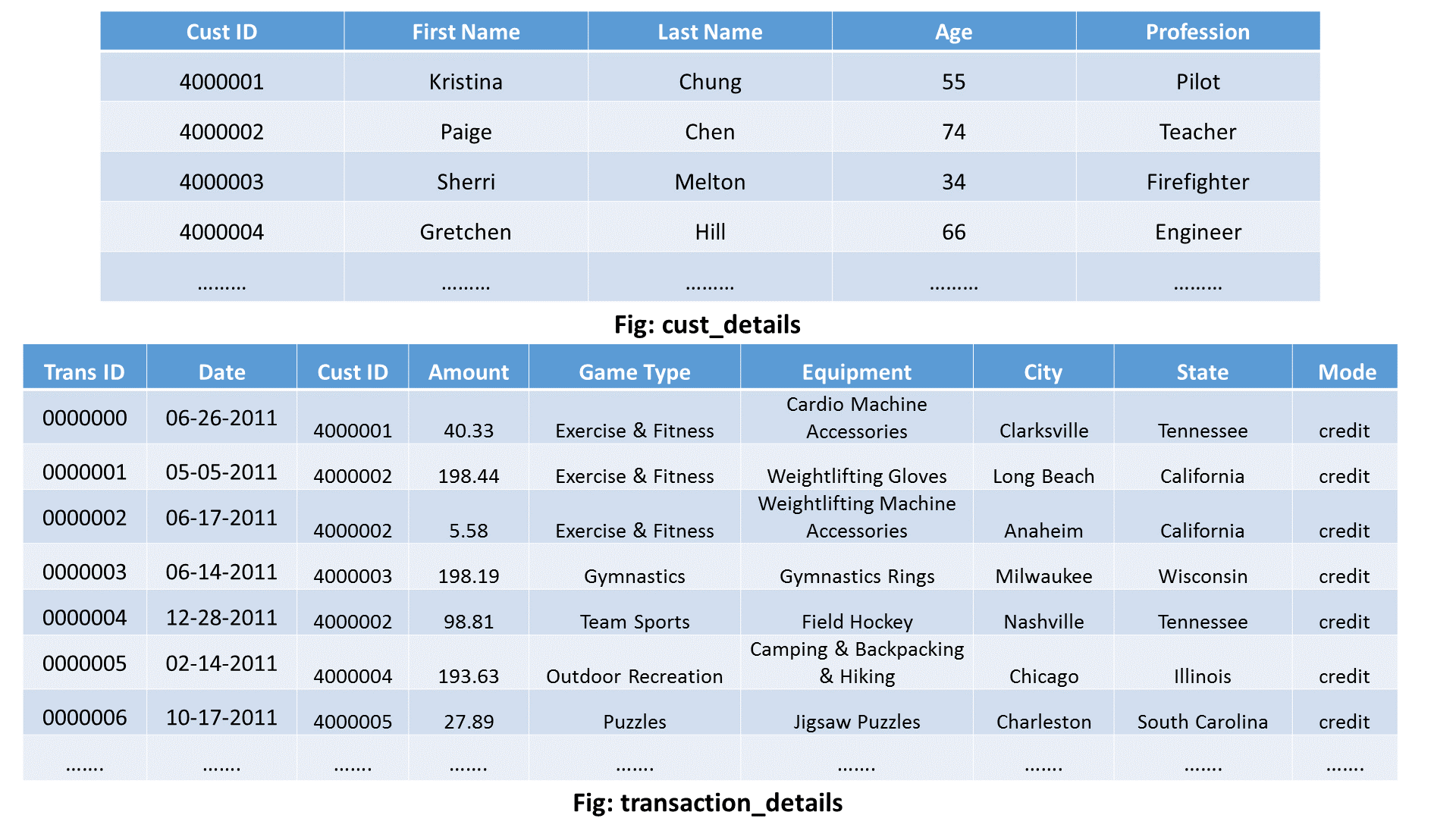Microsoft Azure Data Engineering Certificatio ...
- 13k Enrolled Learners
- Weekend
- Live Class
In this blog, I am going to explain you how a reduce side join is performed in Hadoop MapReduce using a MapReduce example. Here, I am assuming that you are already familiar with MapReduce framework and know how to write a basic MapReduce program. In case you don’t, I would suggest you to go through my previous blog on MapReduce Tutorial so that you can grasp the concepts discussed here without facing any difficulties. The topics discussed in this blog are as follows:
The join operation is used to combine two or more database tables based on foreign keys. In general, companies maintain separate tables for the customer and the transaction records in their database. And, many times these companies need to generate analytic reports using the data present in such separate tables. Therefore, they perform a join operation on these separate tables using a common column (foreign key), like customer id, etc., to generate a combined table. Then, they analyze this combined table to get the desired analytic reports.
Just like SQL join, we can also perform join operations in MapReduce on different data sets. There are two types of join operations in MapReduce:
The map side join has been covered in a separate blog with an example. Click Here to go through that blog to understand how the map side join works and what are its advantages.
Now, let us understand the reduce side join in detail.

As discussed earlier, the reduce side join is a process where the join operation is performed in the reducer phase. Basically, the reduce side join takes place in the following manner:
Meanwhile, you may go through this MapReduce Tutorial video where various MapReduce Use Cases has been clearly explained and practically demonstrated:
Now, let us take a MapReduce example to understand the above steps in the reduce side join.
Suppose that I have two separate datasets of a sports complex:
Using these two datasets, I want to know the lifetime value of each customer. In doing so, I will be needing the following things:

The above figure is just to show you the schema of the two datasets on which we will perform the reduce side join operation. Click on the button below to download the whole project containing the source code and the input files for this MapReduce example:
Kindly, keep the following things in mind while importing the above MapReduce example project on reduce side join into Eclipse:
Now, let us understand what happens inside the map and reduce phases in this MapReduce example on reduce side join:
I will have a separate mapper for each of the two datasets i.e. One mapper for cust_details input and other for transaction_details input.
Mapper for cust_details:
public static class CustsMapper extends Mapper <Object, Text, Text, Text>
{
public void map(Object key, Text value, Context context) throws IOException, InterruptedException
{String record = value.toString();
String[] parts = record.split(",");
context.write(new Text(parts[0]), new Text("cust " + parts[1]));
}
} Key – Value pair: [cust ID, cust name]
Example: [4000001, cust Kristina], [4000002, cust Paige], etc.
Mapper for transaction_details:
public static class TxnsMapper extends Mapper <Object, Text, Text, Text>
{
public void map(Object key, Text value, Context context) throws IOException, InterruptedException
{
String record = value.toString();
String[] parts = record.split(",");
context.write(new Text(parts[2]), new Text("tnxn " + parts[3]));
}
}
Key, Value Pair: [cust ID, tnxn amount]
Example: [4000001, tnxn 40.33], [4000002, tnxn 198.44], etc.
The sorting and shuffling phase will generate an array list of values corresponding to each key. In other words, it will put together all the values corresponding to each unique key in the intermediate key-value pair. The output of sorting and shuffling phase will be of the following format:
Key – list of Values:
Example:
Now, the framework will call reduce() method (reduce(Text key, Iterable<Text> values, Context context)) for each unique join key (cust id) and the corresponding list of values. Then, the reducer will perform the join operation on the values present in the respective list of values to calculate the desired output eventually. Therefore, the number of reducer task performed will be equal to the number of unique cust ID.
Let us now understand how the reducer performs the join operation in this MapReduce example.
If you remember, the primary goal to perform this reduce-side join operation was to find out that how many times a particular customer has visited sports complex and the total amount spent by that very customer on different sports. Therefore, my final output should be of the following format:
Key – Value pair: [Name of the customer] (Key) – [total amount, frequency of the visit] (Value)
public static class ReduceJoinReducer extends Reducer <Text, Text, Text, Text>
{
public void reduce(Text key, Iterable<Text> values, Context context)
throws IOException, InterruptedException
{
String name = "";
double total = 0.0;
int count = 0;
for (Text t : values)
{
String parts[] = t.toString().split(" ");
if (parts[0].equals("tnxn"))
{
count++;
total += Float.parseFloat(parts[1]);
}
else if (parts[0].equals("cust"))
{
name = parts[1];
}
}
String str = String.format("%d %f", count, total);
context.write(new Text(name), new Text(str));
}
}
So, following steps will be taken in each of the reducers to achieve the desired output:
Hence, the final output that my reducer will generate is given below:
Kristina, 651.05 8
Paige, 706.97 6
…..
And, this whole process that we did above is called Reduce Side Join in MapReduce.
The source code for the above MapReduce example of the reduce side join is given below:
import java.io.IOException;
import org.apache.hadoop.conf.Configuration;
import org.apache.hadoop.fs.Path;
import org.apache.hadoop.io.Text;
import org.apache.hadoop.mapreduce.Job;
import org.apache.hadoop.mapreduce.Mapper;
import org.apache.hadoop.mapreduce.Reducer;
import org.apache.hadoop.mapreduce.lib.input.MultipleInputs;
import org.apache.hadoop.mapreduce.lib.input.TextInputFormat;
import org.apache.hadoop.mapreduce.lib.output.FileOutputFormat;
public class ReduceJoin {
public static class CustsMapper extends Mapper <Object, Text, Text, Text>
{
public void map(Object key, Text value, Context context)
throws IOException, InterruptedException
{
String record = value.toString();
String[] parts = record.split(",");
context.write(new Text(parts[0]), new Text("cust " + parts[1]));
}
}
public static class TxnsMapper extends Mapper <Object, Text, Text, Text>
{
public void map(Object key, Text value, Context context)
throws IOException, InterruptedException
{
String record = value.toString();
String[] parts = record.split(",");
context.write(new Text(parts[2]), new Text("tnxn " + parts[3]));
}
}
public static class ReduceJoinReducer extends Reducer <Text, Text, Text, Text>
{
public void reduce(Text key, Iterable<Text> values, Context context)
throws IOException, InterruptedException
{
String name = "";
double total = 0.0;
int count = 0;
for (Text t : values)
{
String parts[] = t.toString().split(" ");
if (parts[0].equals("tnxn"))
{
count++;
total += Float.parseFloat(parts[1]);
}
else if (parts[0].equals("cust"))
{
name = parts[1];
}
}
String str = String.format("%d %f", count, total);
context.write(new Text(name), new Text(str));
}
}
public static void main(String[] args) throws Exception {
Configuration conf = new Configuration();
Job job = new Job(conf, "Reduce-side join");
job.setJarByClass(ReduceJoin.class);
job.setReducerClass(ReduceJoinReducer.class);
job.setOutputKeyClass(Text.class);
job.setOutputValueClass(Text.class);
MultipleInputs.addInputPath(job, new Path(args[0]),TextInputFormat.class, CustsMapper.class);
MultipleInputs.addInputPath(job, new Path(args[1]),TextInputFormat.class, TxnsMapper.class);
Path outputPath = new Path(args[2]);
FileOutputFormat.setOutputPath(job, outputPath);
outputPath.getFileSystem(conf).delete(outputPath);
System.exit(job.waitForCompletion(true) ? 0 : 1);
}
}
Run this Program
Finally, the command to run the above MapReduce example program on reduce side join is given below:
hadoop jar reducejoin.jar ReduceJoin /sample/input/cust_details /sample/input/transaction_details /sample/output
The reduce side join procedure generates a huge network I/O traffic in the sorting and reducer phase where the values of the same key are brought together. So, if you have a large number of different data sets having millions of values, there is a high chance that you will encounter an OutOfMemory Exception i.e. Your RAM is full and therefore, overflown. In my opinion, the advantages of using reduce side join are:
In general, people prefer Apache Hive, which is a part of the Hadoop ecosystem, to perform the join operation. So, if you are from the SQL background, you don’t need to worry about writing the MapReduce Java code for performing a join operation. You can use Hive as an alternative.
Now that you have understood the Reduce Side Join with a MapReduce example, check out the Hadoop training by Edureka, a trusted online learning company with a network of more than 250,000 satisfied learners spread across the globe. The Edureka Big Data Hadoop Certification Training course helps learners become expert in HDFS, Yarn, MapReduce, Pig, Hive, HBase, Oozie, Flume and Sqoop using real-time use cases on Retail, Social Media, Aviation, Tourism, Finance domain.
Got a question for us? Please mention it in the comments section and we will get back to you.
 REGISTER FOR FREE WEBINAR
REGISTER FOR FREE WEBINAR  Thank you for registering Join Edureka Meetup community for 100+ Free Webinars each month JOIN MEETUP GROUP
Thank you for registering Join Edureka Meetup community for 100+ Free Webinars each month JOIN MEETUP GROUP
edureka.co

thank you so much !!
Hey Vincent, we’re glad you liked our blog. Do subscribe to stay posted on upcoming blogs. Cheers!